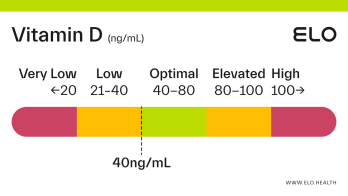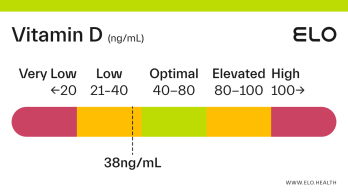Vitamin D: 40 ng/mL

What does a vitamin D level of 40 mean?
A vitamin D level of 40 ng/mL is considered optimal. This means you are likely getting enough vitamin D from your diet, supplements, and/or routine sun exposure to support healthy bones, immune function, and overall health.
Not only is a level of 40 ng/mL good for your overall health, it also puts you at lower risk for certain upper respiratory infections (including COVID-19 and the flu), as well as type 2 diabetes and some autoimmune diseases, like multiple sclerosis, type 1 diabetes, and lupus [4,5,6,7].
How to maintain optimal vitamin D levels
Continue consuming plenty of vitamin D-rich foods by eating foods like salmon, herring, canned tuna, eggs (with the yolk), and fortified milk, yogurt, and breakfast cereals
Get 10–30 minutes of unprotected midday sunlight most days
Continue to take a vitamin D supplement if you were supplementing previously
Check your vitamin D level at least every 6 months (summer and winter) to ensure your levels don’t fall below 40 ng/mL. If your level falls in the winter, you may need to start supplementing or increase your supplement dose to maintain optimal levels.
If you start a new medication, inquire about interactions with vitamin D.
References
National Institutes of Health. (2021, March 26). Office of Dietary Supplements - Vitamin D. National Institutes of Health – Office of Dietary Supplements.
https://ods.od.nih.gov/factsheets/VitaminD-HealthProfessional/
Alshahrani, F., & Aljohani, N. (2013). Vitamin D: deficiency, sufficiency, and toxicity. Nutrients, 5(9), 3605–3616.
https://doi.org/10.3390/nu5093605
Holick M. F. (2009). Vitamin D status: measurement, interpretation, and clinical application. Annals of epidemiology, 19(2), 73–78.
https://doi.org/10.1016/j.annepidem.2007.12.001
Demir, M., Demir, F., & Aygun, H. (2021). Vitamin D deficiency is associated with COVID-19 positivity and severity of the disease. Journal of medical virology, 93(5), 2992–2999.
https://doi.org/10.1002/jmv.26832
Kayaniyil, S., Vieth, R., Retnakaran, R., Knight, J. A., Qi, Y., Gerstein, H. C., Perkins, B. A., Harris, S. B., Zinman, B., & Hanley, A. J. (2010). Association of vitamin D with insulin resistance and beta-cell dysfunction in subjects at risk for type 2 diabetes. Diabetes care, 33(6), 1379–1381.
https://doi.org/10.2337/dc09-2321
Examine.com. (2019, April). A D-fence against cancer?
https://examine.com/members/deep-dives/article/a-d-fence-against-cancer/
Yang, C. Y., Leung, P. S., Adamopoulos, I. E., & Gershwin, M. E. (2013). The implication of vitamin D and autoimmunity: a comprehensive review. Clinical reviews in allergy & immunology, 45(2), 217–226.
https://doi.org/10.1007/s12016-013-8361-3











